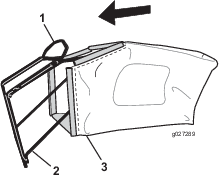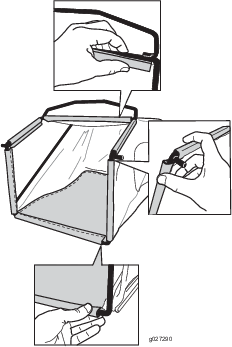| Maintenance Service Interval | Maintenance Procedure |
|---|---|
| Before each use or daily |
|
Introduction
This rotary-blade, walk-behind lawn mower is intended to be used by residential homeowners or professional, hired operators. It is designed primarily for cutting grass on well-maintained lawns on residential or commercial properties. It is not designed for cutting brush or for agricultural uses.
Read this information carefully to learn how to operate and maintain your product properly and to avoid injury and product damage. You are responsible for operating the product properly and safely.
You may contact Toro directly at www.Toro.com for product and accessory information, help finding a dealer, or to register your product.
Whenever you need service, genuine Toro parts, or additional information, contact an Authorized Service Dealer or Toro Customer Service and have the model and serial numbers of your product ready. Figure 1 identifies the location of the model and serial numbers on the product. Write the numbers in the space provided.
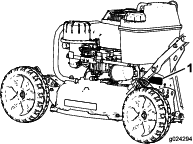
This manual identifies potential hazards and has safety messages identified by the safety-alert symbol (Figure 2), which signals a hazard that may cause serious injury or death if you do not follow the recommended precautions.

This manual uses 2 words to highlight information. Important calls attention to special mechanical information and Note emphasizes general information worthy of special attention.
It is a violation of California Public Resource Code Section 4442 or 4443 to use or operate the engine on any forest-covered, brush-covered, or grass-covered land unless the engine is equipped with a spark arrester, as defined in Section 4442, maintained in effective working order or the engine is constructed, equipped, and maintained for the prevention of fire.
This spark ignition system complies with Canadian ICES-002.
The enclosed Engine Owner's Manual is supplied for information regarding the US Environmental Protection Agency (EPA) and the California Emission Control Regulation of emission systems, maintenance, and warranty. Replacements may be ordered through the engine manufacturer.
Net Torque
The gross or net torque of this engine was laboratory rated by the engine manufacturer in accordance with the Society of Automotive Engineers (SAE) J1940. As configured to meet safety, emission, and operating requirements, the actual engine torque on this class of mower will be significantly lower. Go to www.Toro.com to view specifications on your mower model.
Warning
CALIFORNIA
Proposition 65 Warning
The engine exhaust from this product contains chemicals known to the State of California to cause cancer, birth defects, or other reproductive harm.
Use of this product may cause exposure to chemicals known to the State of California to cause cancer, birth defects, or other reproductive harm.
Safety
This machine meets or exceeds the CPSC blade safety requirements for walk-behind rotary lawn mowers.
Improperly using or maintaining this lawn mower can result in injury. To reduce the potential for injury, comply with these safety instructions.
Toro designed and tested this lawn mower for reasonably safe service; however, failure to comply with the following instructions may result in personal injury.
Warning
Engine exhaust contains carbon monoxide, an odorless, deadly poison that can kill you.
Do not run the engine indoors or in an enclosed area.
To ensure maximum safety, best performance, and to gain knowledge of the product, it is essential that you and any other operator of the lawn mower read and understand the contents of this manual before the engine is ever started. Pay particular attention to the safety-alert symbol (Figure 2) which means Caution, Warning, or Danger. Read and understand the instruction because it has to do with safety. Failure to comply with the instruction may result in personal injury.
General Safety
This machine is capable of amputating hands and feet and of throwing objects. Failure to observe the following safety instructions could result in serious injury or death.
The following instructions have been adapted from the ANSI/OPEI B71.4-2012 standard.
Training
-
Read the Operator's Manual and other training material. If the operator(s) or mechanic(s) cannot read English, it is the owner's responsibility to explain this material to them.
-
Become familiar with the safe operation of the equipment, operator controls, and safety signs.
-
All operators and mechanics should be trained. The owner is responsible for training the users.
-
Never let children or untrained people operate or service the equipment. Local regulations may restrict the age of the operator.
-
The owner/user can prevent and is responsible for accidents or injuries occurring to themselves, other people, or property.
Preparation
-
Use only accessories and attachments approved by the manufacturer.
-
Wear appropriate clothing including eye protection, slip-resistant, substantial footwear, and hearing protection. Tie back long hair. Do not wear jewelry.
-
Inspect the area where the equipment is to be used and remove all objects, such as rocks, toys, and wire, which can be thrown by the machine.
-
Check that operator's presence controls, safety switches, and shields are attached and functioning properly. Do not operate the machine unless they are functioning properly.
Safe Handling of Fuels
-
To avoid personal injury or property damage, use extreme care in handling gasoline. Gasoline is extremely flammable and the vapors are explosive.
-
Extinguish all cigarettes, cigars, pipes, and other sources of ignition.
-
Use only an approved fuel container.
-
Never remove the fuel cap or add fuel with the engine running.
-
Allow the engine to cool before refueling.
-
Never refuel the machine indoors.
-
Never store the machine or the fuel container where there is an open flame, spark, or pilot light, such as on a water heater or on other appliances.
-
Never fill containers inside a vehicle or on a truck or trailer bed with a plastic liner. Always place containers on the ground away from your vehicle before filling.
-
Remove the equipment from the truck or trailer and refuel it on the ground. If this is not possible, then refuel such equipment with a portable container rather than from a fuel dispenser nozzle.
-
Keep the nozzle in contact with the rim of the fuel tank or container opening at all times until fueling is complete.
-
Do not use a nozzle lock-open device.
-
If you spill fuel on clothing, change the clothing immediately.
-
Never overfill the fuel tank. Replace the fuel cap and tighten it securely.
Operation
-
Never run an engine in an enclosed area.
-
Operate the machine only in good light, keeping away from holes and hidden hazards.
-
Start the engine only from the operating position.
-
Be sure of your footing, especially when backing up. Walk, don't run. Never operate the machine on wet grass. Reduced footing could cause slipping.
-
Slow down and use extra care on hillsides. Be sure to travel side to side on hillsides. Turf conditions can affect the stability of the machine. Use caution while operating the machine near drop-offs.
-
Do not operate the machine without either the grass catcher or the guard in place.
-
Do not change the engine governor setting or overspeed the engine.
-
Stop the machine on level ground and shut off the engine before leaving the operating position for any reason, including emptying the catcher or unclogging the chute.
-
Stop the machine and inspect the blade after striking objects or if an abnormal vibration occurs. Make necessary repairs to the machine before resuming operation.
-
Keep hands and feet away from the cutting units.
-
Look behind and down before backing up to be sure of a clear path.
-
Keep pets and bystanders away.
-
Slow down and use caution when crossing roads and sidewalks. Stop the blade if you are not mowing.
-
Be aware of the machine discharge direction and do not point it at anyone.
-
Do not operate the machine while tired, ill, or under the influence of alcohol or drugs.
-
Use care when loading or unloading the machine into a trailer or truck.
-
Use care when approaching blind corners, shrubs, trees, or other objects that may obscure vision.
Maintenance and Storage
-
Shut off the engine and disconnect the spark-plug wire. Wait for all movement to stop before adjusting, cleaning, or repairing the machine.
-
Clean grass and debris from the cutting unit, drive, muffler, and engine to help prevent fires. Clean up oil or fuel spills.
-
Let the engine cool before storing the machine, and do not store it near a flame.
-
Shut off the fuel while storing or transporting the machine. Do not store fuel near flames or drain fuel indoors.
-
Never allow untrained personnel to service the machine.
-
Remove the spark-plug wire before making any repairs.
-
Use care when checking the blade. Wrap the blade or wear gloves, and use caution when servicing the blade. Only replace the blade; never straighten or weld it.
-
Keep hands and feet away from moving parts. If possible, do not make adjustments to the machine while the engine is running.
-
Keep all parts in good working condition and all hardware tightened. Replace all worn or damaged decals.
-
To best protect your investment and maintain optimal performance of your Toro equipment, count on Toro genuine parts. When it comes to reliability, Toro delivers replacement parts designed to the exact engineering specifications of our equipment. For peace of mind, insist on Toro genuine parts.
Hauling
-
Use care when loading or unloading the machine into a trailer or truck.
-
Use full-width ramps for loading the machine into a trailer or a truck.
-
Tie the machine down securely using straps, chains, cable, or ropes. Both the front and the rear straps should be directed down and outward from the machine.
Safety and Instructional Decals
 |
Safety decals and instructions are easily visible to the operator and are located near any area of potential danger. Replace any decal that is damaged or lost. |

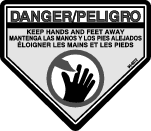


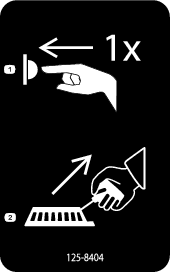


Setup
Note: Determine the left and right sides of the machine from the normal operating position.
Installing the Handle
Parts needed for this procedure:
| Handle | 1 |
| Hex-head-flange bolt (5/16 x 1-1/2 inches) | 2 |
| Carriage bolt (5/16 x 1-1/2 inches) | 2 |
| Flange nut (5/16 inch) | 4 |
-
Remove the cable guard from the handle (Figure 3) by removing the 2 carriage bolts and 2 locknuts that hold the cable guard to the handle.
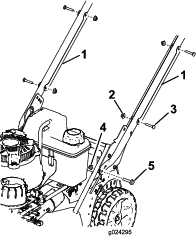
Note: Save the guard, the carriage bolts, and the locknuts so that you can install them onto the handle later in this procedure.
-
Install the handle ends onto the mower housing with 2 hex-head-flange bolts (5/16 x 1-1/2 inches) and 2 flange nuts (5/16 inch) as shown in Figure 3.
-
Set the machine to the desired cutting height; refer to Adjusting the Cutting Height.
-
Route the control cables between the deck and the handle to protect the cables from being damaged (Figure 4).
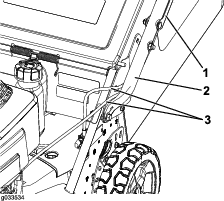
-
Stand in the operating position to determine the handle height that is most comfortable for you (Figure 5).
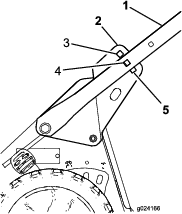
-
Secure the handle onto the handle brackets at your desired handle height with 2 carriage bolts (5/16 x 1-1/2 inches) and 2 flange nuts (5/16 inch) as shown in Figure 6.
Important: Ensure that the bolt heads are on the inside of the handle and the nuts are on the outside of the handle.
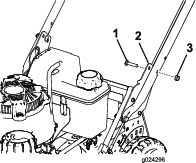
-
Position the cable guard onto the handle with the cable(s) inside the guard, and secure the guard to the handle with the 2 carriage bolts and the 2 locknuts that you previously removed (Figure 3).
Important: Ensure that you do not pinch the cable(s) to the handle when you install the cable guards onto the handle.
Installing the Recoil-Start Rope
Pull the recoil-start rope through the rope guide on the handle (Figure 7).
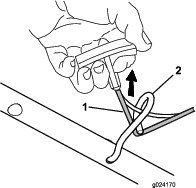
Note: To make the rope easier to install, squeeze the blade-control bar on the handle.
Filling the Crankcase with Oil
The engine crankcase is shipped without oil. Before starting the engine, fill the crankcase with oil. The engine crankcase (with oil filter) can hold 0.85 L (29 oz) of oil. Use only high-quality SAE 10W-30 weight detergent oil that has the American Petroleum Institute (API) service classification SH, SJ, or equivalent.
Before each use, ensure that the oil level is between the Add and the Full marks on the dipstick (Figure 8).
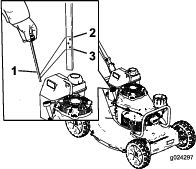
Note: When the crankcase is empty, pour about 3/4 of the crankcase capacity of oil in the crankcase, then follow the procedure in this section.
-
Move the machine onto a level surface.
-
Clean around the dipstick (Figure 8).
-
Remove the dipstick by rotating the cap counterclockwise and pulling it out.
-
Wipe the dipstick clean with a clean cloth.
-
Insert the dipstick into the filler neck, then remove the dipstick.
-
Read the oil level on the dipstick.
-
If the oil level is below the Add mark on the dipstick, slowly pour a small amount of oil into the oil-fill tube, wait 3 minutes, and repeat steps 4 through 6 until the oil level is at the Full mark on the dipstick.
-
If the oil level is above the Full mark on the dipstick, drain the excess oil until the oil level on the dipstick is at the Full mark.
Important: If the oil level in the crankcase is too low or too high and you run the engine, you may damage the engine.
-
-
Insert the dipstick into the filler neck and rotate the cap clockwise until it is tight.
Adjusting the Self-Propel Drive
Important: You must adjust the self-propel-drive cable before you operate the machine for the first time. Refer to Adjusting the Self-Propel Drive.
Assembling the Grass Bag
Product Overview
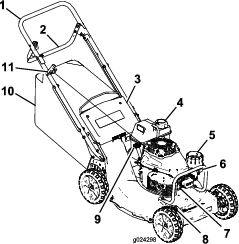
Operation
Note: Determine the left and right sides of the machine from the normal operating position.
Each time before you mow, ensure that the self-propel drive and the blade-control bar operate properly. When you release the blade-control bar, the blade and the self-propel drive should stop. If they do not, contact an Authorized Service Dealer.
Caution
This machine produces sound levels in excess of 85dBA at the operator's ear and can cause hearing loss through extended periods of exposure.
Wear hearing protection when operating this machine.

Checking the Engine-Oil Level
Before you use the machine, ensure that the oil level is between the Add and the Full marks as shown on the dipstick (Figure 13).

If the oil level is below the Add mark, add oil. Refer to Changing the Engine Oil.
Filling the Fuel Tank
Danger
Gasoline is extremely flammable and explosive. A fire or explosion from gasoline can burn you and others.
-
To prevent a static charge from igniting the gasoline, place the container and/or machine directly on the ground before filling, not in a vehicle or on an object.
-
Fill the tank outdoors when the engine is cold. Wipe up spills.
-
Do not handle gasoline when smoking or around an open flame or sparks.
-
Store gasoline in an approved fuel container, out of the reach of children.
-
For best results, use only clean, fresh (less than 30 days old), unleaded gasoline with an octane rating of 87 or higher ((R+M)/2 rating method).
-
Oxygenated fuel with up to 10% ethanol or 15% MTBE by volume is acceptable.
-
Ethanol: Gasoline with up to 10% ethanol (gasohol) or 15% MTBE (methyl tertiary butyl ether) by volume is acceptable. Ethanol and MTBE are not the same. Gasoline with 15% ethanol (E15) by volume is not approved for use. Never use gasoline that contains more than 10% ethanol by volume, such as E15 (contains 15% ethanol), E20 (contains 20% ethanol), or E85 (contains up to 85% ethanol). Using unapproved gasoline may cause performance problems and/or engine damage which may not be covered under warranty.
-
Do not use gasoline containing methanol.
-
Do not store fuel either in the fuel tank or in fuel containers over the winter unless you use a fuel stabilizer.
-
Do not add oil to gasoline.
Important: To reduce starting problems, add fuel stabilizer/conditioner to fresh fuel as directed by the fuel-stabilizer manufacturer.
Note: The capacity of the fuel tank is 3.76 L (0.99 US gallon).

Adjusting the Cutting Height
You can change the cutting height at each wheel by adjusting a cutting-height lever. Cutting heights are 25 mm (1 inch), 38 mm (1-1/2 inches), 51 mm (2 inches), 64 mm (2-1/2 inches), 76 mm (3 inches), 89 mm (3-1/2 inches), 102 mm (4 inches), 114 mm (4-1/2 inches).
Danger
Adjusting the cutting-height levers could bring your hands into contact with a moving blade and result in serious injury.
-
Shut off the engine and wait for all movement to stop before adjusting the cutting height.
-
Do not put your fingers under the housing when adjusting the cutting height.
-
Pull the cutting-height lever toward the wheel (Figure 15) and move the lever to the desired setting.

-
Release the cutting-height lever and seat it securely in the notch.
-
Adjust all the wheels to the same cutting-height setting.
Starting the Engine
-
Connect the spark-plug wire to the spark plug.
-
Open the fuel valve (Figure 16).
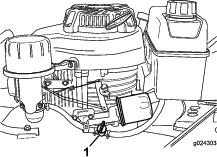
-
Firmly push in the primer (Figure 17), holding the primer bulb in for 1 second.
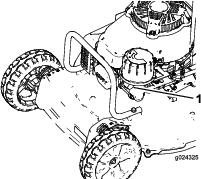
-
Hold the blade-control bar in the Run/Shift position, about 2.5 cm (1 inch) below the handle (Figure 18).
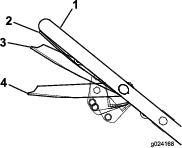
-
Pull the starter handle lightly until you feel resistance, pull it sharply, then allow it to return slowly to the rope guide on the handle.
Note: If the engine does not start, repeat steps 3 through 5.
Shutting Off the Engine
Release the blade-control bar. Both the engine and the blade should stop within 3 seconds. If they do not, contact an Authorized Service Dealer.
Note: Close the fuel valve (Figure 16) if you will not be starting the engine soon afterward.
Operating the Self-Propel Drive
This machine has 3 ground speeds: 1 (slow), 2 (medium), and 3 (fast); it also has a Neutral (N) position. The self-propel-drive lever is located below and behind the fuel tank (Figure 19).
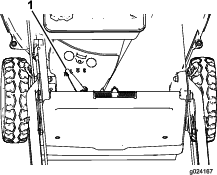
-
Move the self-propel-drive lever to the desired ground speed.
-
Start the engine.
-
Squeeze the blade-control bar against the handle to the Run/Drive position (Figure 20).

Important: Shifting speeds while squeezing the blade-control bar against the handle in the Run/Drive position could damage the transmission. Move the blade-control bar to the Run/Shift position (Figure 20) whenever you change the ground speed.
Note: You can vary the ground speed by increasing or decreasing the distance between the blade-control bar and the handle. Lower the bar to decrease the ground speed when you are making a turn or if the machine is moving too fast for you. If you lower the bar too far, the machine stops self-propelling. Squeeze the bar closer to the handle to increase the ground speed. When you hold the bar tight against the handle, the machine self-propels at the maximum ground speed. Move the self-propel-drive lever to the NEUTRAL position when you use the machine for trimming.
Recycling the Clippings
This machine comes from the factory ready to recycle grass and leaf clippings back into the lawn. To prepare the machine to recycle:
-
If the grass bag is on the machine, remove it; refer to Removing the Grass Bag.
-
If the rear-discharge plug is not installed, grip it by the handle, raise the rear door, and insert it into the rear-discharge chute until the latch locks into place (Figure 21).
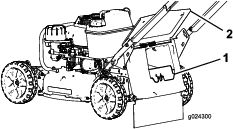
Warning
Operating the machine to recycle lawn clippings without the plug in place allows objects to be thrown toward you or bystanders. Also, contact with the blades could occur. Thrown objects or blade contact can cause serious injury or death.
Ensure that the rear-discharge plug is in place before you recycle the clippings. Never engage the blades without either the rear-discharge plug or the grass bag installed on the machine.
Bagging the Clippings
Use the grass bag when you want to collect grass and leaf clippings from the lawn.
Warning
A worn grass bag could allow small stones and other similar debris to be thrown toward you or bystanders, resulting in serious personal injury or death.
Check the grass bag frequently. If it is damaged, install a new Toro replacement bag.
Warning
The blades are sharp; contacting the blades can result in serious personal injury.
Shut off the engine and wait for all moving parts to stop before leaving the operating position.
Installing the Grass Bag
-
Shut off the engine and wait for all moving parts to stop.
-
Raise and hold up the rear door (Figure 22).
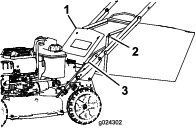
-
Remove the rear-discharge plug by pushing in the latch with your thumb and pulling the plug out from the machine (Figure 21).
-
Install the bag-rod ends into the notches at the base of the handle, and rock the bag back and forth to ensure that the bag-rod ends are seated at the bottom of both notches (Figure 22).
-
Lower the rear door until it rests on the grass bag.
Removing the Grass Bag
Danger
The machine can throw grass clippings and other objects through an opening in the mower housing. Objects thrown with enough force could cause serious personal injury or death to you or to bystanders.
-
Never remove the grass bag and then start the engine without the discharge plug installed on the machine.
-
Never open the rear door on the machine when the engine is running.
-
Shut off the engine and wait for all moving parts to stop.
-
Raise the rear door.
-
Remove the bag rod on the grass bag from the notches at the base of the handle (Figure 22).
-
Install the discharge plug; refer to Recycling the Clippings.
-
Lower the rear door.
Operating Tips
General Tips
-
Review the safety instructions and read this manual carefully before operating the machine.
-
Clear the area of sticks, stones, wire, branches, and other debris that the blade could hit and throw.
-
Keep everyone, especially children and pets, away from the area of operation.
-
Avoid striking trees, walls, curbs, or other solid objects. Never deliberately mow over any object.
-
If the machine strikes an object or starts to vibrate, immediately shut off the engine, disconnect the wire from the spark plug, and examine the machine for damage.
-
Maintain a sharp blade throughout the cutting season. Periodically file down nicks on the blade.
-
Replace the blade when necessary with an original Toro replacement blade.
-
Mow only dry grass or leaves. Wet grass and leaves tend to clump on the yard and can cause the machine to plug or the engine to stall.
Warning
Wet grass or leaves can cause serious injury if you slip and contact the blade.
Mow only in dry conditions.
-
Clean under the machine after each mowing; refer to Cleaning under the Machine.
-
Keep the engine in good running condition.
-
Clean the air filter frequently. Mulching stirs up more clippings and dust which clogs the air filter and reduces engine performance.
-
Set the engine speed to the fastest position for the best cutting results.
Warning
Operating a machine with its engine running at a speed greater than the factory setting can cause the machine to throw a part of the blade or engine toward you or bystanders, resulting in serious personal injury or death.
-
Do not change the engine speed setting.
-
If you suspect the engine speed is faster than normal, contact an Authorized Service Dealer.
-
Cutting Grass
-
Grass grows at different rates at different times of the year. In the summer heat, it is best to cut grass at the 64 mm (2-1/2 inch), 76 mm (3 inch), or 89 mm (3-1/2 inch) cutting-height settings. Cut only about a third of the grass blade at a time. Do not cut below the 64 mm (2-1/2 inch) setting unless the grass is sparse or it is late fall when grass growth begins to slow down.
-
When cutting grass over 15 cm (6 inches) tall, first mow at the highest cutting height setting and walk slower; then mow again at a lower setting for the best lawn appearance. If the grass is too long and the leaves clump on top of the lawn, the machine may plug and cause the engine to stall.
-
Alternate the mowing direction. This helps disperse the clippings over the lawn for even fertilization.
If the finished lawn appearance is unsatisfactory, try 1 or more of the following:
-
Sharpen the blade.
-
Walk at a slower pace while mowing.
-
Raise the cutting height on your machine.
-
Cut the grass more frequently.
-
Overlap cutting swaths instead of cutting a full swath with each pass.
Cutting Leaves
-
After cutting the lawn, ensure that half of the lawn shows through the cut leaf cover. You may need to make more than a single pass over the leaves.
-
For light leaf coverage, set all the wheels at the same cutting height setting.
-
Slow down your mowing speed if the machine does not cut the leaves finely enough.
Maintenance
Note: Determine the left and right sides of the machine from the normal operating position.
Recommended Maintenance Schedule(s)
| Maintenance Service Interval | Maintenance Procedure |
|---|---|
| After the first 8 hours |
|
| After the first 25 hours |
|
| Before each use or daily |
|
| Every 25 hours |
|
| Every 40 hours |
|
| Every 50 hours |
|
| Every 100 hours |
|
| Every 200 hours |
|
| Every 300 hours |
|
Important: Refer to your engine owner's manual for additional maintenance procedures.
Caution
If you leave the wire on the spark plug, someone could accidently start the engine and seriously injure you or bystanders.
Disconnect the wire from the spark plug before you do any maintenance. Set the wire aside so that it does not accidently contact the spark plug.
Engine Maintenance
Servicing the Air Cleaner
| Maintenance Service Interval | Maintenance Procedure |
|---|---|
| Every 25 hours |
|
| Every 300 hours |
|
Important: Do not operate the engine without the air filter assembly in place; otherwise, extreme engine damage will occur.
-
Shut off the engine and wait for all moving parts to stop.
-
Disconnect the wire from the spark plug.
-
Remove the cover and clean it thoroughly (Figure 23).
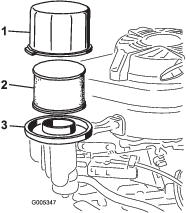
-
Remove and the foam pre-cleaner and the paper-air filter from the air-cleaner base (Figure 23)
-
Remove the foam pre-cleaner from the paper air filter, and wash the foam pre-cleaner with a mild detergent and water, then blot it dry.
-
Inspect the paper air filter, and replace it if it is excessively dirty.
Important: Do not try to clean a paper filter.
-
Install the foam pre-cleaner onto the paper air filter.
-
Install the foam pre-cleaner and paper air filter onto the air-cleaner base.
-
Install the cover.
Changing the Engine Oil
| Maintenance Service Interval | Maintenance Procedure |
|---|---|
| After the first 8 hours |
|
| Every 100 hours |
|
| Oil Capacity | |
| With oil filter | 0.85 L (29 oz) |
| Without oil filter | 0.65 L (22 oz) |
-
Run the engine to warm the engine oil.
Note: Warm oil flows better and carries more contaminants.
Warning
Oil may be hot after engine has been run, and contact with hot oil can cause severe personal injury.
Avoid contacting the hot engine oil when you drain it.
-
Shut off the engine and wait for all moving parts to stop.
-
Disconnect the wire from the spark plug.
-
Close the fuel valve (Figure 16).
-
Drain the gasoline from the fuel tank.
-
Place a suitable drain pan under the dipstick/oil drain.
-
Clean around the dipstick.
-
Remove the dipstick by rotating the cap counterclockwise and pulling it out.
-
Tip the machine onto its right side (air filter up) to drain the oil into the drain pan.
-
After draining the oil, return the machine to the operating position.
-
Fill the crankcase to the Full mark on the dipstick with fresh oil; refer to Changing the Engine Oil.
-
Insert the dipstick into the filler neck and rotate the cap clockwise until it is tight.
-
Wipe up any spilled oil.
-
Recycle the used oil according to local codes.
Changing the Engine-Oil Filter
| Maintenance Service Interval | Maintenance Procedure |
|---|---|
| Every 200 hours |
|
-
Run the engine to warm the oil.
Warning
Oil may be hot after the engine has been run, and contact with hot oil can cause severe personal injury.
Avoid contacting the hot engine oil when you drain it.
-
Shut off the engine and wait for all moving parts to stop.
-
Disconnect the wire from the spark plug.
-
Drain the gasoline from the fuel tank.
-
Drain the engine oil; refer to Changing the Engine Oil.
-
Place a rag under the oil filter (Figure 24) to catch any oil that may leak out as you remove the oil filter.
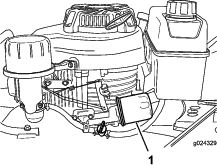
-
Remove the oil filter.
-
Use your finger to coat the gasket on the new oil filter with oil (Figure 26).
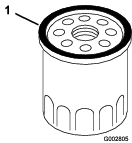
-
Install the new filter by rotating it clockwise until the seal contacts the filter housing, then rotate the filter an additional 3/4 turn by hand.
-
Fill the crankcase to the Full line on the dipstick with fresh oil; refer to Changing the Engine Oil.
-
Connect the wire to the spark plug.
-
Run the engine for about 3 minutes.
-
Shut off the engine, wait for all moving parts to stop, and check for oil leakage around the filter.
-
Add oil to compensate for the oil in the oil filter. Refer to Checking the Engine-Oil Level.
-
Recycle the used oil filter properly.
Servicing the Spark Plug
| Maintenance Service Interval | Maintenance Procedure |
|---|---|
| Every 100 hours |
|
Use an NGK BPR5ES spark plug or equivalent.
-
Shut off the engine and wait for all moving parts to stop.
-
Disconnect the wire from the spark plug.
-
Clean around the spark plug.
-
Remove the spark plug from the cylinder head.
Important: Replace a cracked, fouled, or dirty spark plug. Do not clean the electrodes because grit entering the cylinder can damage the engine.
-
Set the gap on the plug to 0.76 mm (0.030 inch); refer to Figure 26.
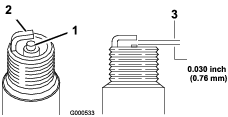
-
Carefully install the spark plug by hand (to avoid cross threading) until it is hand tight.
-
Tighten the spark plug to 23 N∙m (2.3 kgf-m, 17 ft-lb).
Important: A loose spark plug can become very hot and can damage the engine; overtightening a spark plug may damage the threads in the cylinder head.
-
Connect the wire to the spark plug.
Drive System Maintenance
Adjusting the Self-Propel Drive
If the machine is new, does not self-propel, or it tends to creep forward, adjust the drive cable.
-
Move the machine outside and onto a paved surface near a solid wall to safely prevent the machine from moving forward while the engine is running.
-
Position the machine with the front tires against the wall.
Note: Ensure that the area is well ventilated and clear of debris that could be thrown by the machine.
-
Shift the transmission to third gear.
-
Start the engine; refer to Starting the Engine.
-
Pull the self-propel-drive bar to the handle.
Note: The wheels should start to turn as the self-propel-drive bar just touches the handle.
-
Shut off the engine.
-
If you must adjust the machine, do the following:
-
If the wheels do not spin when you engage the self-propel-drive bar, the traction belt is too loose. Rotate the wheel-drive-control knob (Figure 27) clockwise 1 turn and repeat steps 4 through 6.
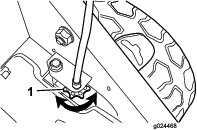
-
If the wheels spin before you fully engage the self-propel-drive bar, the traction belt is too tight. Rotate the wheel-drive-control knob (Figure 27) counterclockwise 1 turn and repeat steps 4 through 6.
-
-
For a new traction belt, rotate the drive cable adjustment knob clockwise 1 additional turn to allow for the normal stretching of the belt during the break-in period.
Note: You can skip this step if you are adjusting a used belt.
Brake Maintenance
Adjusting the Blade-Brake Cable
If the blade brake cable needs to be replaced or is not adjusted properly, adjust the blade brake cable.
-
Shut off the engine and wait for all moving parts to stop.
-
Disconnect the wire from the spark plug.
-
Hold the blade-control bar at 19 cm (7-5/8 inches) from the top of the handle as shown in Figure 28.
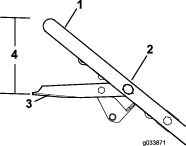
-
Loosen the cable-anchor nut.
-
Pull down on the cable conduit to remove the slack from the brake cable.
-
Tighten the cable-anchor nut.
-
Release the blade-control bar and verify there is slack in the brake cable.
Blade Maintenance
Maintaining the Blade
Always mow with a sharp blade. A sharp blade cuts cleanly and without tearing or shredding the grass blades.
-
Shut off the engine and wait for all moving parts to stop.
-
Disconnect the wire from the spark plug.
-
Close the fuel valve by moving the fuel-valve lever to the left (Figure 16).
-
Drain the gasoline from the fuel tank.
-
Tip the machine onto its right side (air cleaner up) as shown in Figure 29.
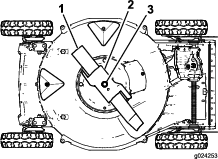
Inspecting the Blade
| Maintenance Service Interval | Maintenance Procedure |
|---|---|
| Before each use or daily |
|
Carefully examine the blade for sharpness and wear, especially where the flat and the curved parts meet (Figure 30A). Because sand and abrasive material can wear away the metal that connects the flat and curved parts of the blade, check the blade before using the machine. If you notice a slot or wear (Figure 30B and Figure 30C), replace the blade; refer to Removing the Blade.
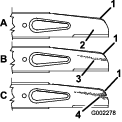
Note: For the best performance, install a new blade before the mowing season begins. During the year, file down any small nicks to maintain the cutting edge.
Danger
A worn or damaged blade can break, and a piece of the blade could be thrown toward you or bystanders, resulting in serious personal injury or death.
-
Inspect the blade periodically for wear or damage.
-
Replace a worn or damaged blade.
Inspecting the Accelerator
| Maintenance Service Interval | Maintenance Procedure |
|---|---|
| Before each use or daily |
|
Carefully examine the accelerator for excessive wear (Figure 31). Because sand and abrasive material can wear away the metal (especially in the area shown as item 2 in Figure 31), check the accelerator before using the machine. If you notice that a tab on the accelerator has been worn down to a sharp edge or there is a crack, replace the accelerator.

Warning
A worn or damaged accelerator can break, and a piece of the accelerator could be thrown at you or bystanders, resulting in serious personal injury or death.
-
Inspect the accelerator periodically for wear or damage.
-
Replace a worn or damaged accelerator.
Removing the Blade
-
Grasp the end of the blade using a rag or a thickly padded glove.
-
Remove the blade bolt, the lock washer, the accelerator, and the blade (Figure 30).
Sharpening the Blade
| Maintenance Service Interval | Maintenance Procedure |
|---|---|
| Every 50 hours |
|
File the top side of the blade to maintain its original cutting angle (Figure 32A) and inner cutting edge radius (Figure 32B). The blade will remain balanced if you remove the same amount of material from both cutting edges.

Balancing the Blade
-
Check the balance of the blade by placing the center hole of the blade over a nail or screwdriver shank clamped horizontally in a vise (Figure 33).

Note: You can also check the balance using a commercially manufactured blade balancer.
-
If either end of the blade rotates downward, file that end (not the cutting edge or the end near the cutting edge) until neither end of the blade drops.
Installing the Blade
-
Install a sharp, balanced Toro blade, the accelerator, the lock washer, and the blade bolt. The sail of the blade must point toward the top of the mower housing for proper installation.
Note: Torque the blade bolt to 82 N∙m (60 ft-lb).
Warning
Operating the machine without the accelerator in place can cause the blade to flex, bend, or break, resulting in serious injury or death to you or to bystanders.
Do not operate the machine without the accelerator in place.
-
Return the machine to the operating position.
Cleaning
Cleaning under the Machine
To ensure the best performance, keep the underside of the machine clean. Be especially careful to keep the kickers free of debris (Figure 34).
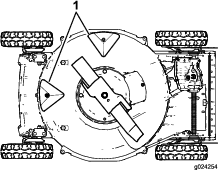
Washing Method
| Maintenance Service Interval | Maintenance Procedure |
|---|---|
| Before each use or daily |
|
Warning
The machine may dislodge material from under the machine.
-
Wear eye protection.
-
Stay in the operating position (behind the handle) while the engine is running.
-
Do not allow bystanders in the area.
-
Position the machine on a flat concrete or asphalt surface near a garden hose.
-
Start the engine.
-
Hold the running garden hose at handle level and direct the water to flow on the ground just in front of the right, rear wheel (Figure 35).

Note: The blade will draw in water and wash out the clippings. Let the water run until you no longer see clippings being washed out from under the machine.
-
Shut off the engine and wait for all moving parts to stop.
-
Turn off the water.
-
Start the machine and let it run for a few minutes to dry out the underside of the machine.
Scraping Method
If washing does not remove all debris from under the machine, scrape it clean.
-
Disconnect the wire from the spark plug.
-
Drain the gasoline from the fuel tank.
Warning
Tipping the machine may cause the gasoline to leak from the carburetor or the fuel tank. Gasoline is extremely flammable, highly explosive, and, under certain conditions, can cause personal injury or property damage.
Avoid fuel spills by running the engine dry or by removing the gasoline with a hand pump; never siphon.
-
Tip the machine onto its right side (air cleaner up).
-
Remove the dirt and grass clippings with a hardwood scraper. Avoid burrs and sharp edges.
-
Return the machine to the operating position.
-
Connect the wire to the spark plug.
Cleaning under the Belt Cover
| Maintenance Service Interval | Maintenance Procedure |
|---|---|
| Every 50 hours |
|
-
Shut off the engine and wait for all moving parts to stop.
-
Disconnect the wire from the spark plug.
-
Remove the belt cover (Figure 36).
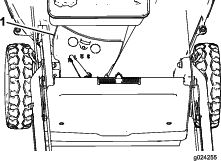
-
Lift off the cover and brush out all the debris around the belt area.
-
Install the belt cover.
-
Connect the wire to the spark plug.
Cleaning the Wheels
| Maintenance Service Interval | Maintenance Procedure |
|---|---|
| Every 40 hours |
|
-
Remove the rear wheels and clean any debris from the wheel-gear area.
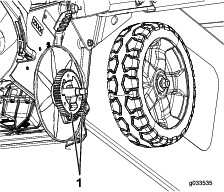
-
After cleaning, apply a small amount of anti-seize compound to the gears.
Note: If you operate the machine in extreme conditions, cleaning the wheels more frequently than recommended will increase gear life.
Note: To prevent damage to the bearing seals, do not use a high pressure water spray on the bearings.
Storage
To prepare the machine for off-season storage, perform the recommended maintenance procedures; refer to .
Store the machine in a cool, clean, dry place. Cover the machine to keep it clean and protected.
Preparing the Fuel System
Warning
Gasoline can vaporize if you store it over long periods of time and explode if it comes into contact with an open flame.
-
Do not store gasoline over long periods of time.
-
Do not store the machine with gasoline in the fuel tank or the carburetor in an enclosure with an open flame. (For example, a furnace or a water heater pilot light.)
-
Allow the engine to cool before storing it in any enclosure.
Empty the gasoline from the fuel tank when mowing for the last time before storing the machine.
-
Run the engine until it shuts off from running out of fuel.
-
Choke the engine and start it again.
-
Allow the engine to run until it shuts off. When you can no longer start the engine, it is sufficiently dry.
Preparing the Engine
-
While the engine is still warm, change the oil in the crankcase; refer to Changing the Engine Oil.
-
Remove the spark plug.
-
Using an oil can, add about 30 ml (1 oz) of engine oil to the engine crankcase through the spark-plug hole.
-
Slowly rotate the engine several times by pulling the recoil-start handle to distribute the oil throughout the engine crankcase.
-
Install the spark plug but do not connect the wire to the spark plug.
General Information
-
Clean under the machine; refer to Cleaning under the Machine.
-
Clean any dirt and chaff from the cylinder, cylinder head fins, and blower housing.
-
Remove grass clippings, dirt, and grime from the external parts of the engine, the shrouding, and the top of the mower housing.
-
Check the condition of the blade; refer to Inspecting the Blade.
-
Service the air cleaner; refer to Servicing the Air Cleaner.
-
Tighten all nuts, bolts, and screws.
-
Touch up all rusted or chipped paint surfaces with paint available from an Authorized Service Dealer.
Removing the Machine from Storage
-
Check and tighten all fasteners.
-
Remove the spark plug and spin the engine rapidly using the starter to blow out the excess oil from the cylinder.
-
Clean the spark plug or replace it if it is cracked, broken, or if the electrodes are worn.
-
Install the spark plug; refer to Servicing the Spark Plug.
-
Perform any needed maintenance procedures; refer to .
-
Fill the fuel in the fuel tank with fresh gasoline.
-
Check the engine-oil level.
-
Connect the wire to the spark plug.
Troubleshooting
| Problem | Possible Cause | Corrective Action |
|---|---|---|
| The engine does not start. |
|
|
| The engine starts hard or loses power. |
|
|
| The engine runs rough. |
|
|
| The machine or engine vibrates excessively. |
|
|
| The is an uneven cutting pattern. |
|
|
| The discharge chute plugs up. |
|
|
| The machine does not self-propel. |
|
|
